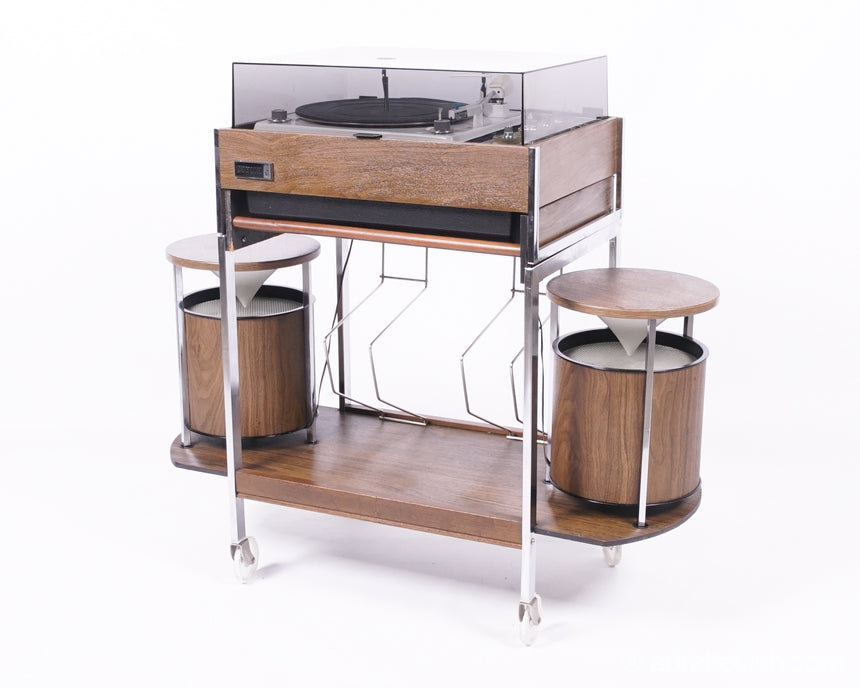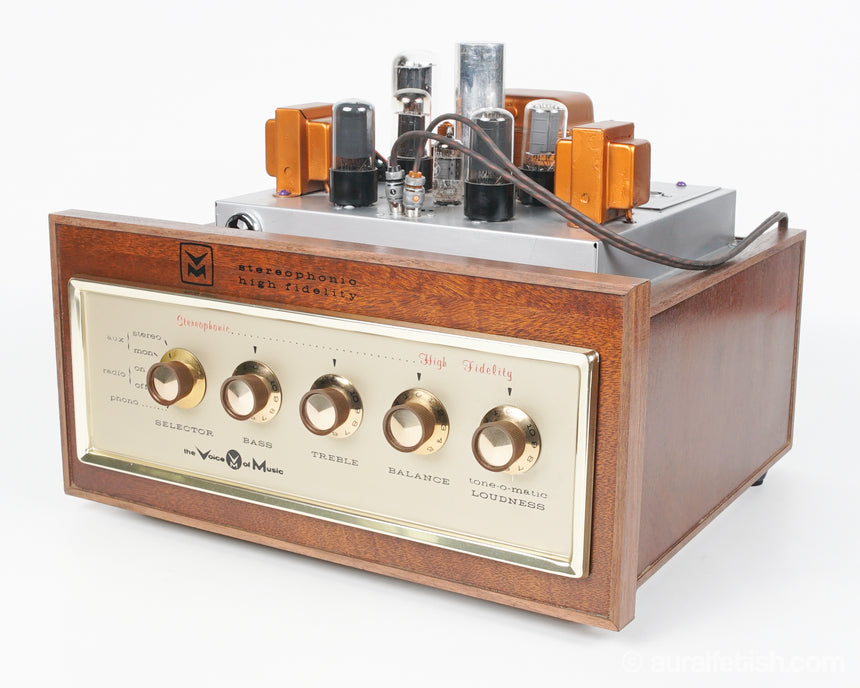THE HISTORY OF V-M / THE VOICE OF MUSIC

V-M Corporation was founded in June 1944 by Walter Miller in Benton Harbor, Michigan. The company originally manufactured only 78 rpm record changers and labeled them simply as "A V-M Product". The brand name "Voice of Music" was suggested by a V-M engineer and first used in 1952.
V-M designed a two speed changer after Columbia Records introduced the LP in 1948, then added the 45rpm speed after RCA brought that innovation to market in 1949. In 1954, V-M added the fourth speed (16⅔ rpm) for "talking books." A new changer mechanism, used throughout the 1950s, 1960s, and 1970s was developed in 1950. The basic design was retained until record changer production was terminated and was updated throughout the years to keep V-M's record changers aligned with their competitors. The speed control mechanism was, however, completely redesigned in 1961. V-M Corporation claimed that their record changers were jam proof and enjoyed a reputation of being both well built and reliable. These mass-produced record changers, while competitive with other manufactures products, i.e. BSR and Garrard, in both build quality and product specifications, were not competitive with professional record changers. Like other mass-produced record changers, the tone arms had heavier vertical tracking force (VTF), poorer speed accuracy rumble specification than the professional record changers. V-M mass-produced record changers, like their competitors' offerings, were used in low- to medium-priced audio equipment - compact systems, console stereos, and portable systems. Unlike their competitors, V-M often customized their units for large OEM customers with uniquely styled controls, tonearms, and trim pieces. They were sold also as separate components. Most had ceramic cartridges dual stylii, with a separate stylus for LPs/45s, and one for 78rpm records. Most had two pole synchronous motors.
Amplified phonographs were introduced in the early 1950s, and V-M introduced the Model 700 tape recorder late in 1954. Throughout the 1950s and 1960s, tape recorders, phonographs, consoles and components by V-M were popular with consumers for a variety of reasons. V-M Corporation's "Educational Systems" tape recorders and phonos with rugged cases were popular with schools and institutions. A brief entry into the audiophile market in 1970 with the V-M "Professional Series" was technically successful - but by this point, V-M Corporation was too financially weak to back a successful marketing campaign, so these products are rare and sought after today.
First and foremost, V-M was a record changer and tape deck supplier (less the electronics) to dozens of familiar brand names of their day, such as Zenith and Motorola to name only two. V-M Corporation, from the late 1950s through 1968, was the world's largest record changer manufacturer. During the peak years of record changer production, V-M Corporation produced more record changers than all other record changer manufacturers combined. In the early 1960s, V-M Corporation advertisements, placed in an audio magazine, stating this fact. Also, in this advertisement, V-M listed their original equipment manufacturers, (customers), by name. BSR Ltd, a British record changer manufacturer, in the 1970s, copied the format of this ad. By 1969, BSR had surpassed V-M Corporation in record changer production to become the world largest manufacturer of record changers. In several countries, V-M record changers were produced under license. Telefunken, of then West Germany, was an example of one such manufacturer signing a licensing agreement with V-M Corporation, to utilize their record changer technology. JVC is known to have produced a copy of the V-M 1200 series without license. Large record changer production volumes helped V-M keep its own Voice of Music brand profitable for many years. After 1965, the trend became clear that American audio companies were going out of business or shifting production overseas. As V-M's record changer volumes declined, it became difficult for the company to remain profitable. Retailing began to change from small "mom and pop" stores (V-M's strength) to large electronics retailers where V-M was under-represented. At the end of 1972 year, V-M quit offering console stereos and terminated all tape recorder models, for sale to retail customers, with the exception of an eight track player. At the end of the 1974 year, all other remaining retail products, except record changers, were discontinued. After 1974, V-M record changers were the only consumer product sold to the retail market as components. Record changers continued to be sold to original equipment manufacturers up to the bankruptcy, in mid July, 1977. Cassette decks still produced, after leaving the retail consumer market, were highly specialized professional units. Some of the companies that bought these professional cassette decks were New Century Education Corporation, Beltone, and Terra Technology. V-M also did contract engineering projects for various manufacturers, along with some assembly projects for outside companies. For the December 1976 Christmas Season, V-M assembled an electronic ping pong game for Factory Direct Marketing. V-M filed for bankruptcy in mid July 1977 when a power failure in New York City prevented a wire transfer of critically needed funds.




